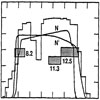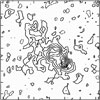- Eric Keto's Home Page
- High Mass Stars
- Starless Cores
- Extragalactic
- Radiative Transfer
- Hydrodynamics
- SMA Instrumentation
- IR Instrumentation
- MOLLIE radiative transfer
- Keto Prize
- Textbooks
|
The Berkeley Mid-Infrared Array Camera | ||||
|
Abstract The authors present a characterization of some processes affecting the performance of solid state array cameras designed for ground based astronomical imaging in the 8-13 um atmospheric window. The discussion includes a novel model for electron-hole generation - recombination noise based on the probable pathlength of an electron in a photoconductor. The authors use the Berkeley mid-IR Array Camera as an example. For this camera, the results show that the total optical system composed of the camera, a 3 m telescope, and the atmosphere has an efficiency of about 3%, a 1 sigma noise equivalent flux density of 25 mJy / min^0.5 arcsec^2 measured over a 10% band width, and a noise equivalent expressed as the ambient temperature thermal black body noise of 23%.
Abstract We observed the nearby starburst galaxy NGC 253 in the mid-infrared to obtain a three-dimensional data set with arcsecond angular resolution and 0.2 um spectral resolution. The observations show the major spectral features in the upper half of the mid-IR window: the 11.3 um polycyclic aromatic hydrocarbon (PAH) line and the 12.8 um [Ne II] line as well as the broad silicate absorption feature at 9.7 um. We use the [Ne II] line to determine the emission measure of the ionized gas, and in combination with radio observations to predict the thermal and nonthermal contributions to the radio continuum. The amount of ionized gas is related to the rate of star formation. Based on the mid-IR spectra, we identify three major components in the nucleus of NGC 243: an AGN in the center of the galaxy, a super-star cluster also seen in optical images, and a larger scale diffuse envelope composed of an older population of supernova remnants and lower mass stars. Eric Keto, Joseph L. Hora, G.G. Fazio, William Hoffmann, Lynne Deutsch, ApJ, 518, 183
| ||||
|
|


